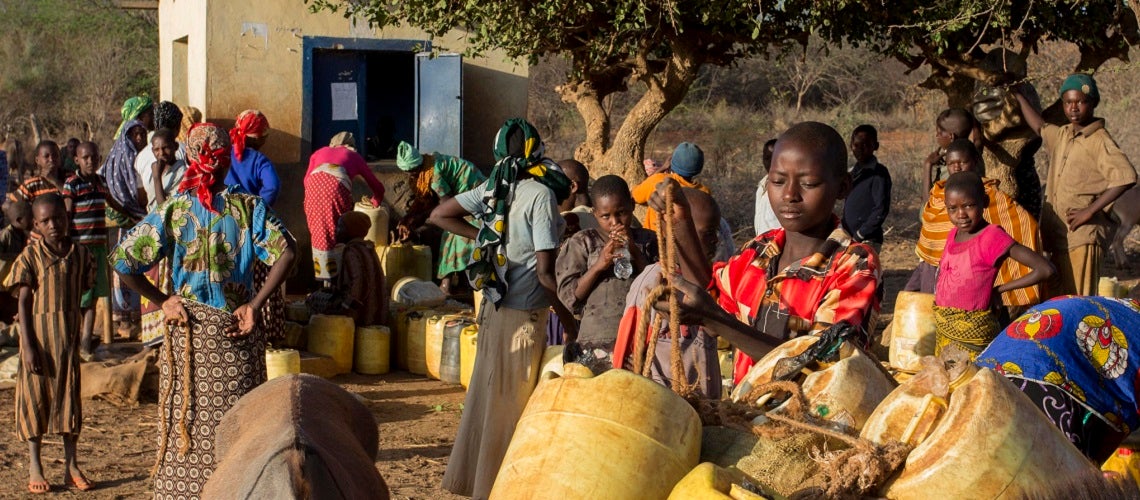 Villagers queuing for water at a pump in Kenya's arid Eastern Province
Villagers queuing for water at a pump in Kenya's arid Eastern Province
Partway through 2022 and this is already shaping up to be a year of devastating climate impacts affecting lives and livelihoods around the world: from disastrous flooding in Bangladesh to scorching heatwaves in South Asia and Europe. Climate action is also in danger of stalling: the war in Ukraine, COVID-19, surging inflation, and food prices are further compounding efforts to tackle the climate crisis.
This is certainly a challenging landscape.
But there is also much to be hopeful for. Despite the economic aftershocks of the pandemic, countries and businesses showed up in Glasgow for COP26 willing to renew their commitments on climate. Technologies and innovations are transforming sectors like energy and transport, making low-carbon options more affordable, efficient, and scalable much more rapidly than was previously thought possible. It’s also clear that countries can achieve good development outcomes while also taking action on climate, by decarbonizing economies and ensuring a just transition, as well as investing in adaptation and resilience.
"It’s also clear that countries can achieve good development outcomes while also taking action on climate, by decarbonizing economies and ensuring a just transition, as well as investing in adaptation and resilience."
This fundamental connection between development and climate is a core pillar of the World Bank Group’s Climate Change Action Plan, 2021-25. And it is why we are working on an innovative, country-focused diagnostic: the Country Climate and Development Reports which will look at both, help identify key priorities and support policy makers as they think through how to minimize and manage unavoidable tradeoffs.
Deploying this approach – one that integrates climate and development priorities – is what also gives me hope. I have worked on global development issues for over thirty years, from sustainable development to infrastructure, across multiple continents and country contexts, and across the nexus of analytics, policy reforms and financing. I know the vital the importance of wide-ranging partnerships, stakeholder inclusion, and the power of global knowledge to inform and shape local country solutions. I am looking forward to bringing these perspectives to the Bank’s work on climate, in particular on three fronts:
First, supporting countries to significantly and quickly reduce greenhouse gas (GHG) emissions:
I mentioned multiple crises that could stall climate action. The clearest impact will be on the investments in clean energy that are core to reducing emissions. It is critical to identify, fund and implement the most impactful projects in terms of GHG emissions. In some sectors – like clean energy or electric vehicles - the solutions are already here and largely competitive. Private investors can speed up their adoption, so that scarce resources go to more research and development in areas like improving battery storage and supporting more vulnerable communities. To address the significant financing needs for the low-carbon transition, developing countries will also need substantial funding from the global community as well as early-stage technical assistance for project preparation. We will also need much stronger engagement and capital from the private sector – which needs to increase by an order of magnitude – to address these immense costs.
Second, investments in resilience pay off:
Coming for the water sector, I have seen how climate change wreaks havoc on the water cycle, with climate impacts expressed through increased frequency and severity of droughts and floods. Every $1 spent on resilient infrastructure yields $4 in cost savings. Low- and middle-income countries lose an estimated $390 billion each year to disruptions of power, transportation, water, and telecommunications services caused by natural disasters. Improving the resilience of those networks would cost about 3 percent of the total capital investment, but the avoided disruptions would save four times that amount – an estimated $4.2 trillion over the useful life of new infrastructure.
Given climate impacts already affecting lives and livelihoods, especially in the world’s poorest countries, we have committed to 50% of all Bank climate finance supporting adaptation and resilience. Investing in resilience goes beyond hard infrastructure: it goes to the very core of how people and communities are affected by climate change. For instance, the poorer communities are, the more vulnerable they are to climate change. At the same time, climate shocks also make communities poorer: natural disasters already push 26 million people into poverty every year, and by the end of this decade, as many as 132 million people could be living in extreme poverty because of climate change. But good development can make a huge difference. Reducing poverty also reduces climate vulnerability, because development gains – from higher income and savings and better education to access to infrastructure services and health care – also make individuals and communities more resilient to climate change. So the Bank’s work to reduce poverty is also making people less vulnerable to climate change, and making them less vulnerable to climate change, reduces poverty and helps ensure people’s wellbeing.
And finally, all of us have a part to play:
The climate crisis is a profoundly unequal one – it may affect us all, but not equally. Countries that contributed the least to global emissions, will face its worst impacts. As richer countries are using their purchasing power to fill energy gaps, we unfortunately see more of them shifting to dirtier fuel sources. This makes it harder for developing countries to pursue transitions to renewable energy. The burden of doing the right thing cannot be placed on the poorest countries which already have limited fiscal space and large energy needs. The challenge for developing countries is that they no longer have an opportunity to develop first in a high carbon-intensive way and then clean up and decarbonize later. They need support today and to make investments now to slow a changing climate and enable billions to live safer, more prosperous, inclusive, and sustainable lives.
Countries, businesses, investors and multilateral institutions – like ours – are stepping up. But we can all do much more to ensure the low-carbon, resilient transition is a reality. Every fraction of a degree to limit dangerous temperature rise will count. And every single drop that we all bring can help put out the fire.


Join the Conversation